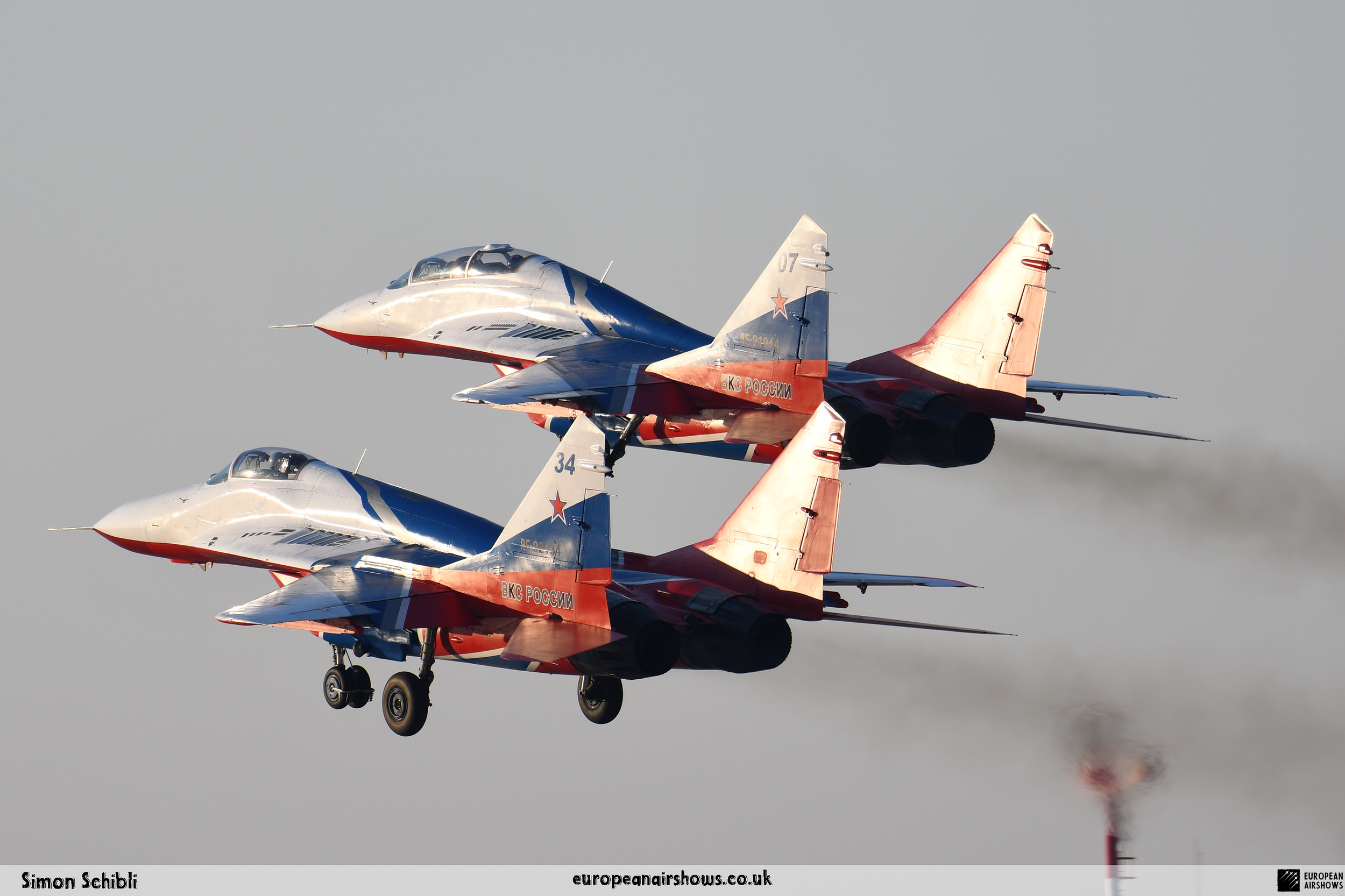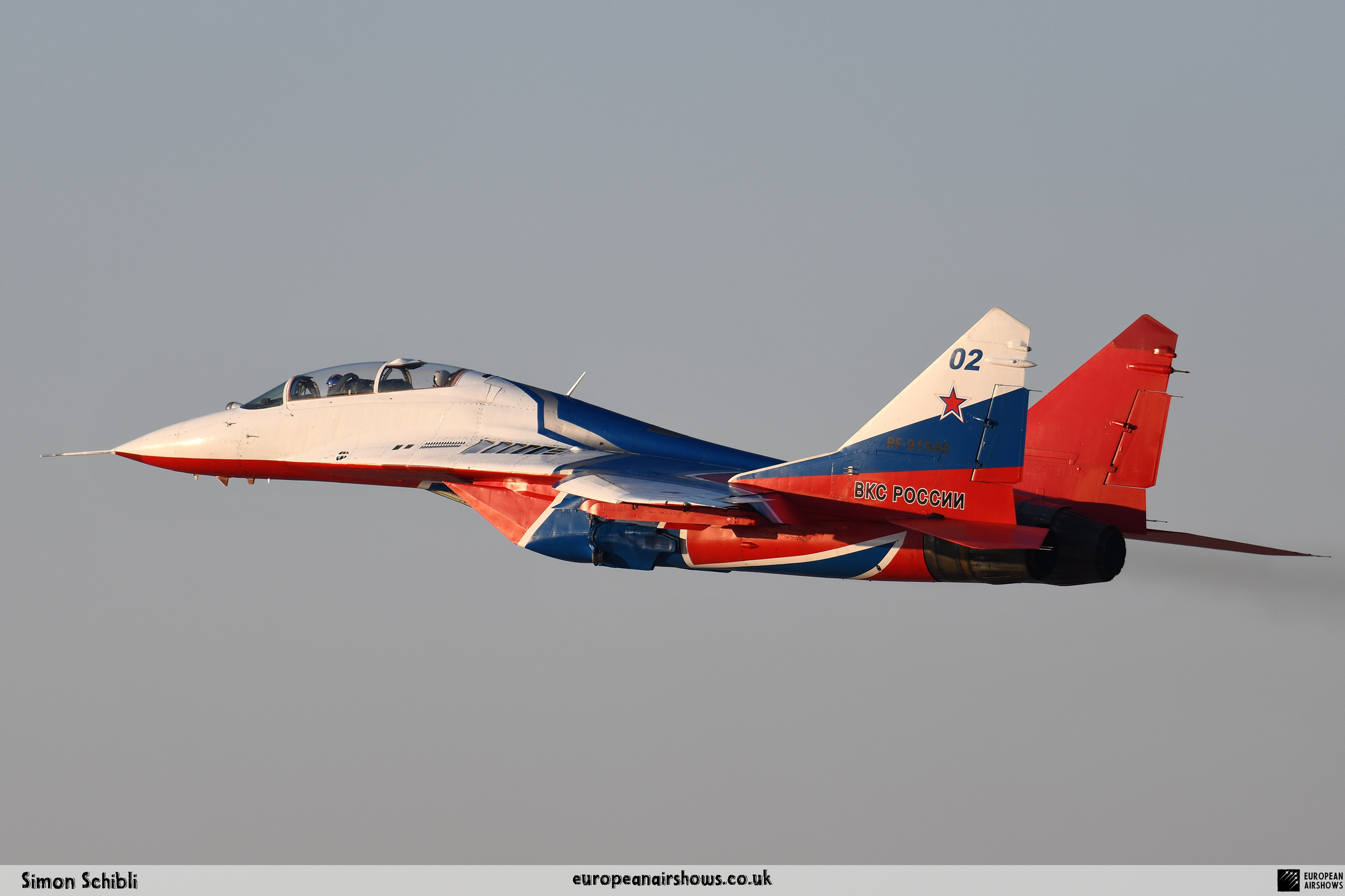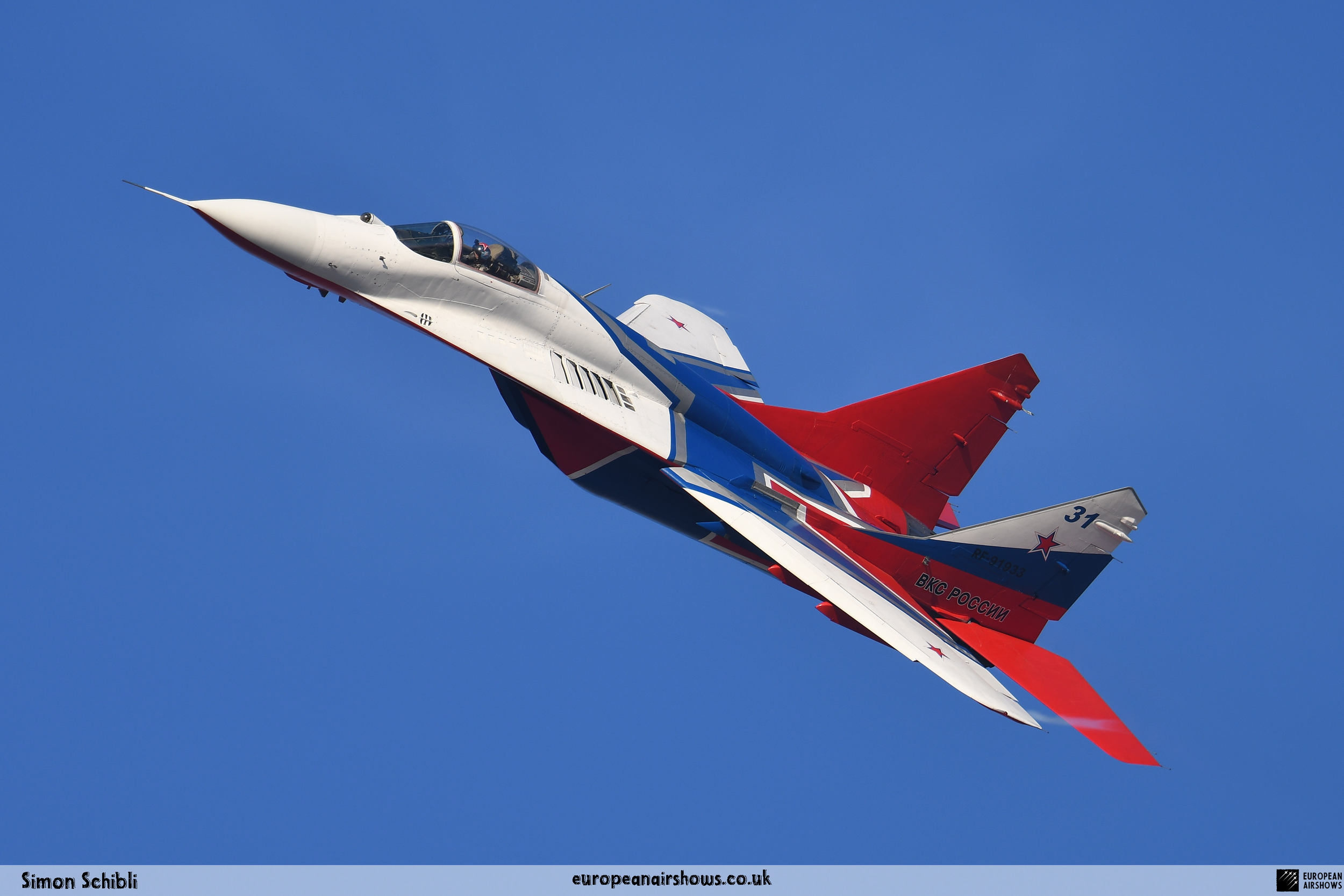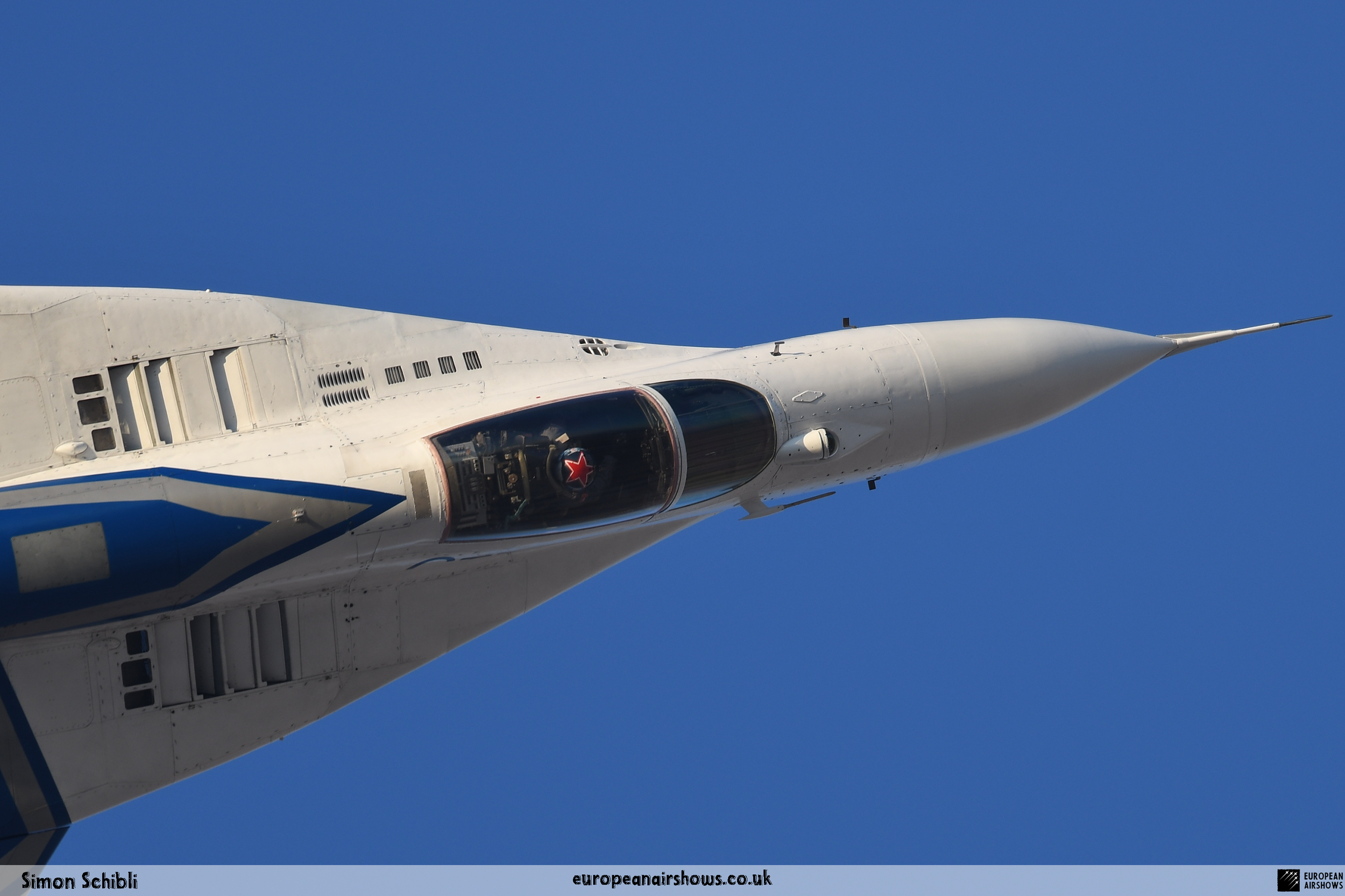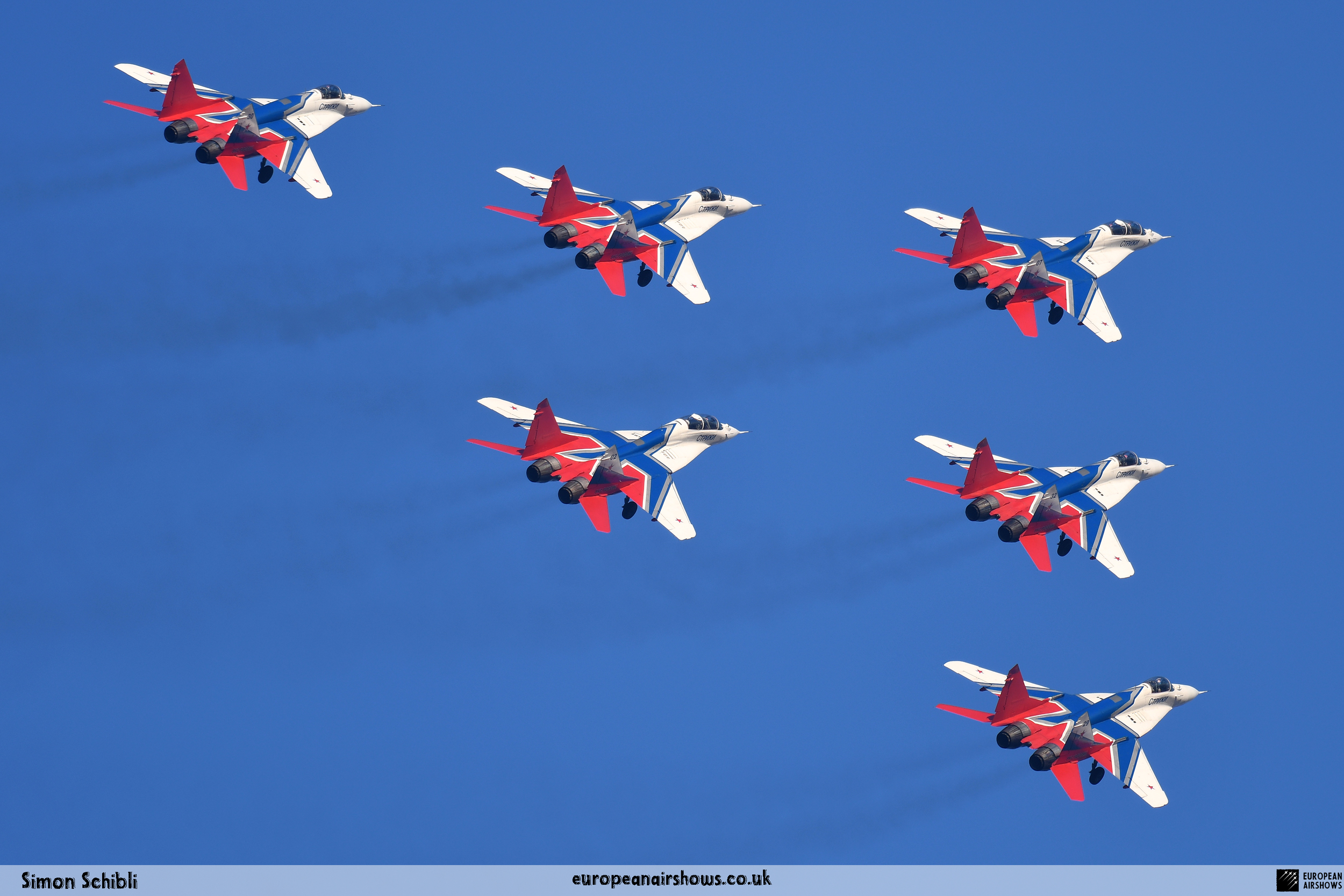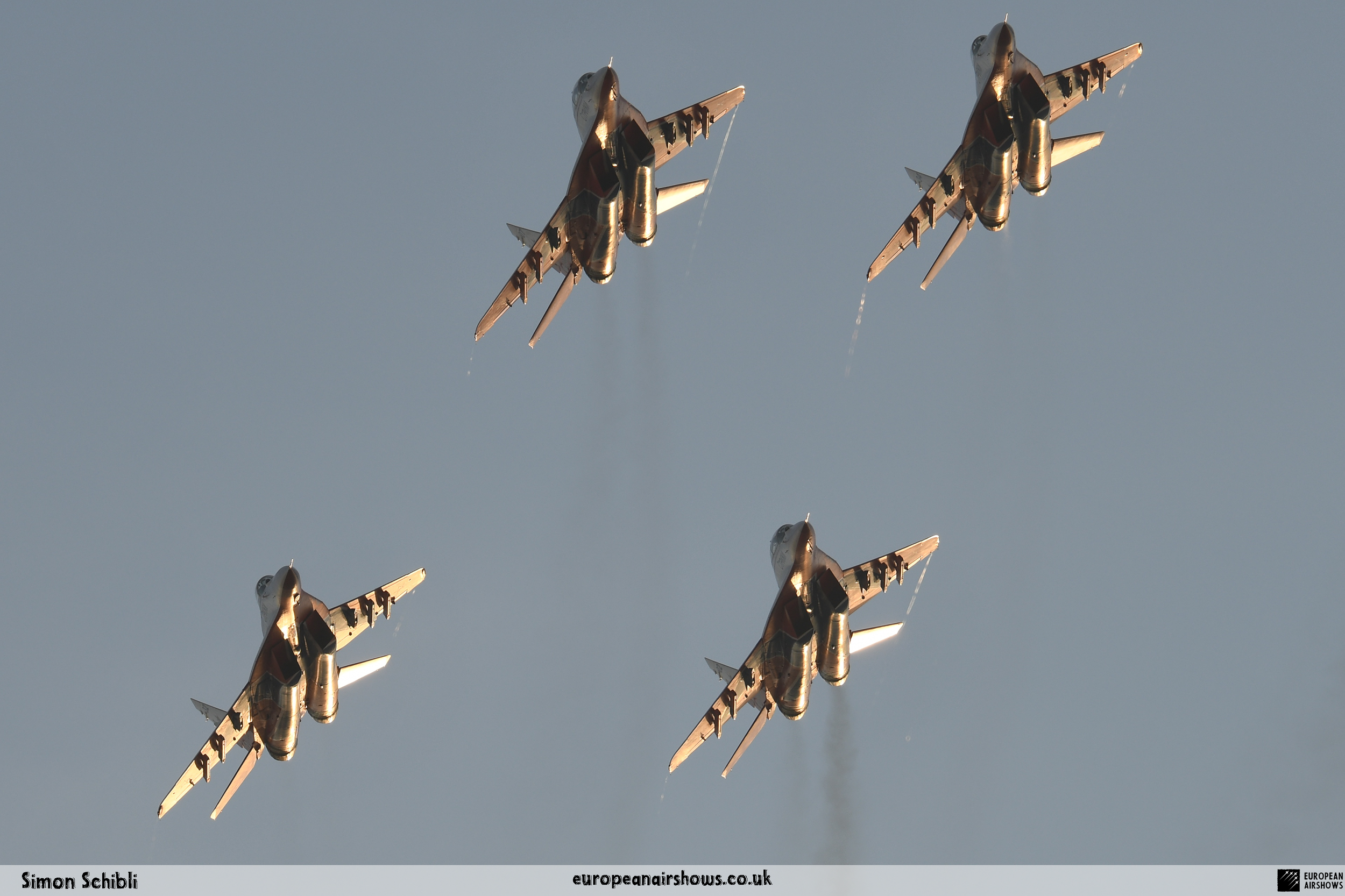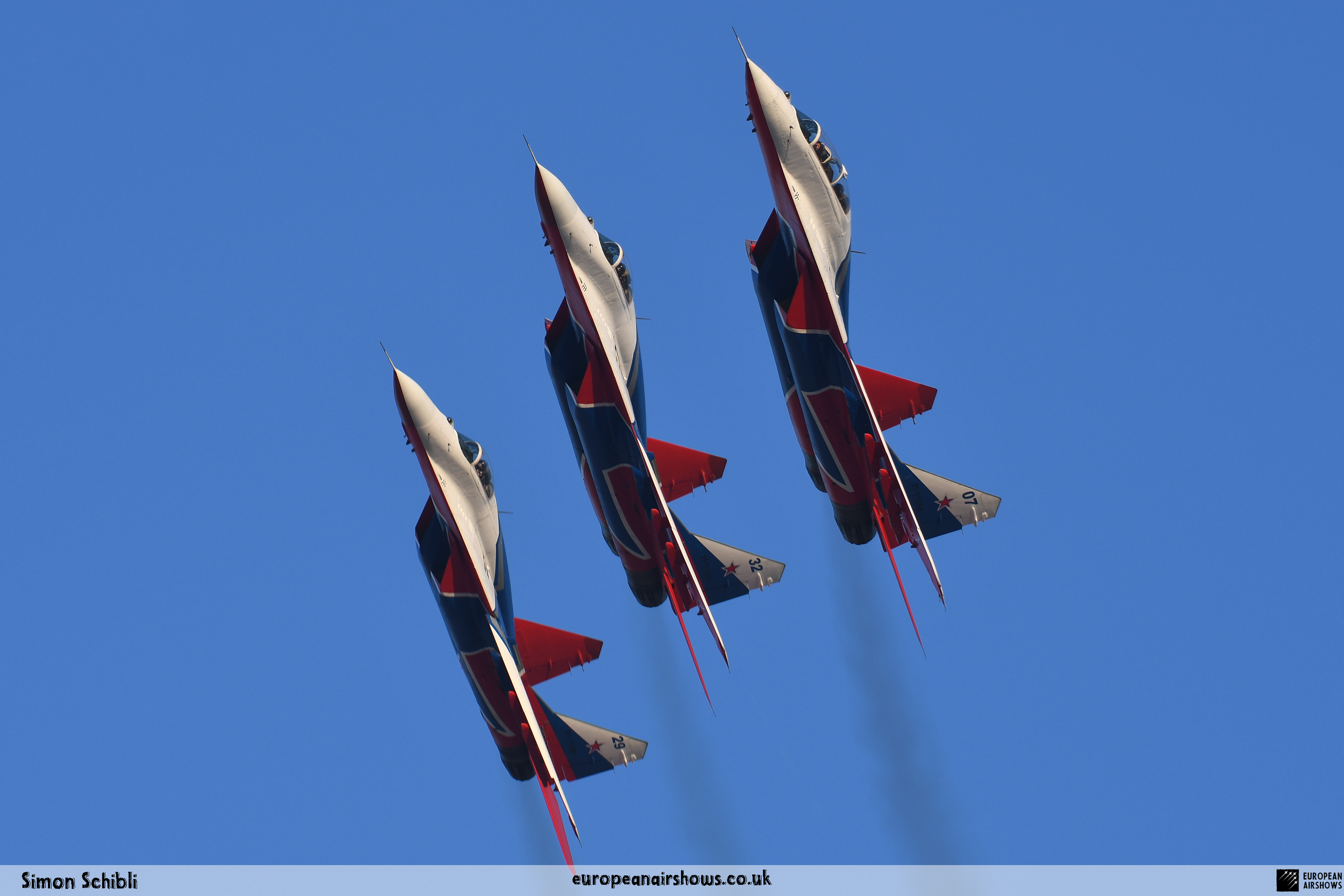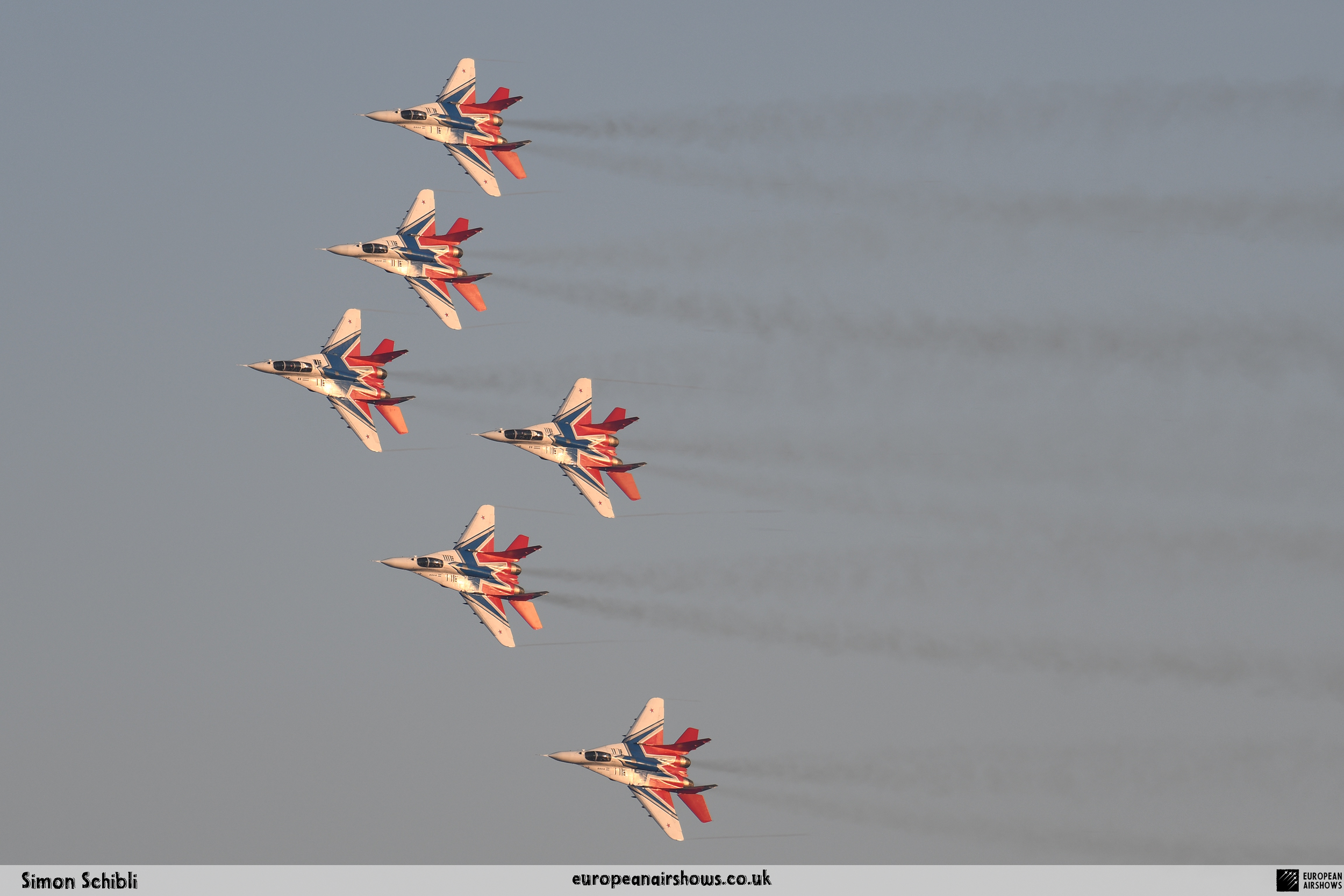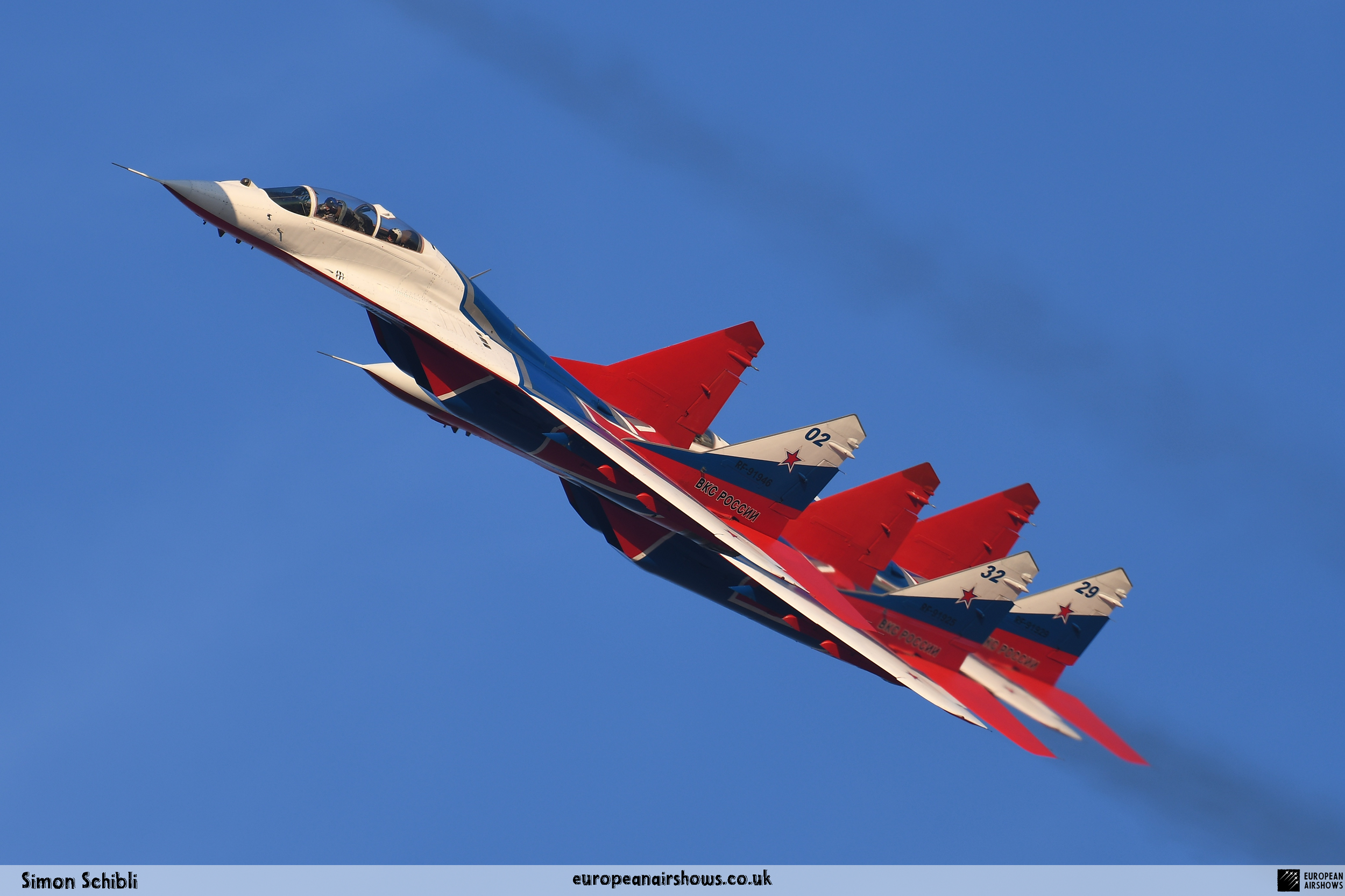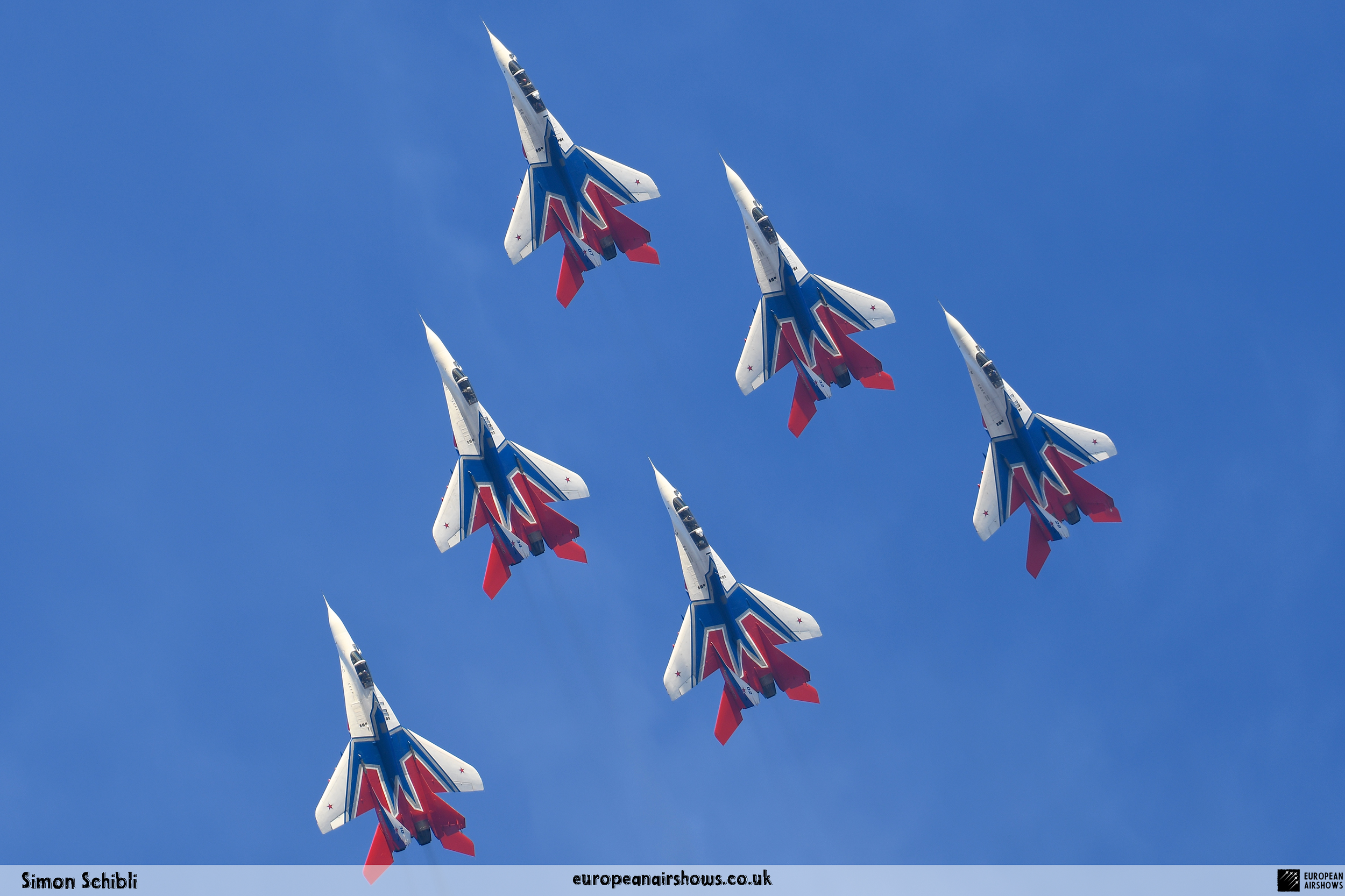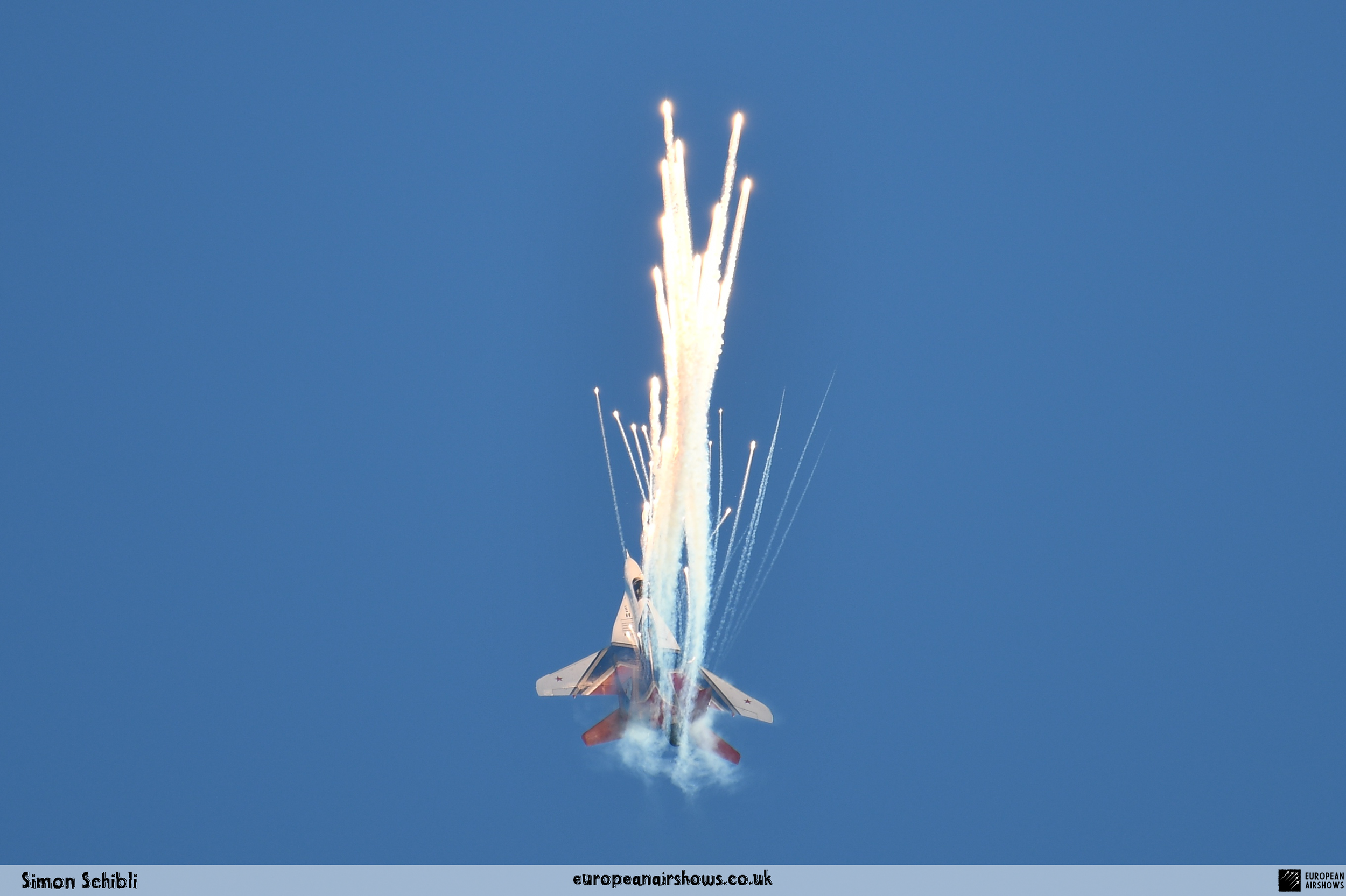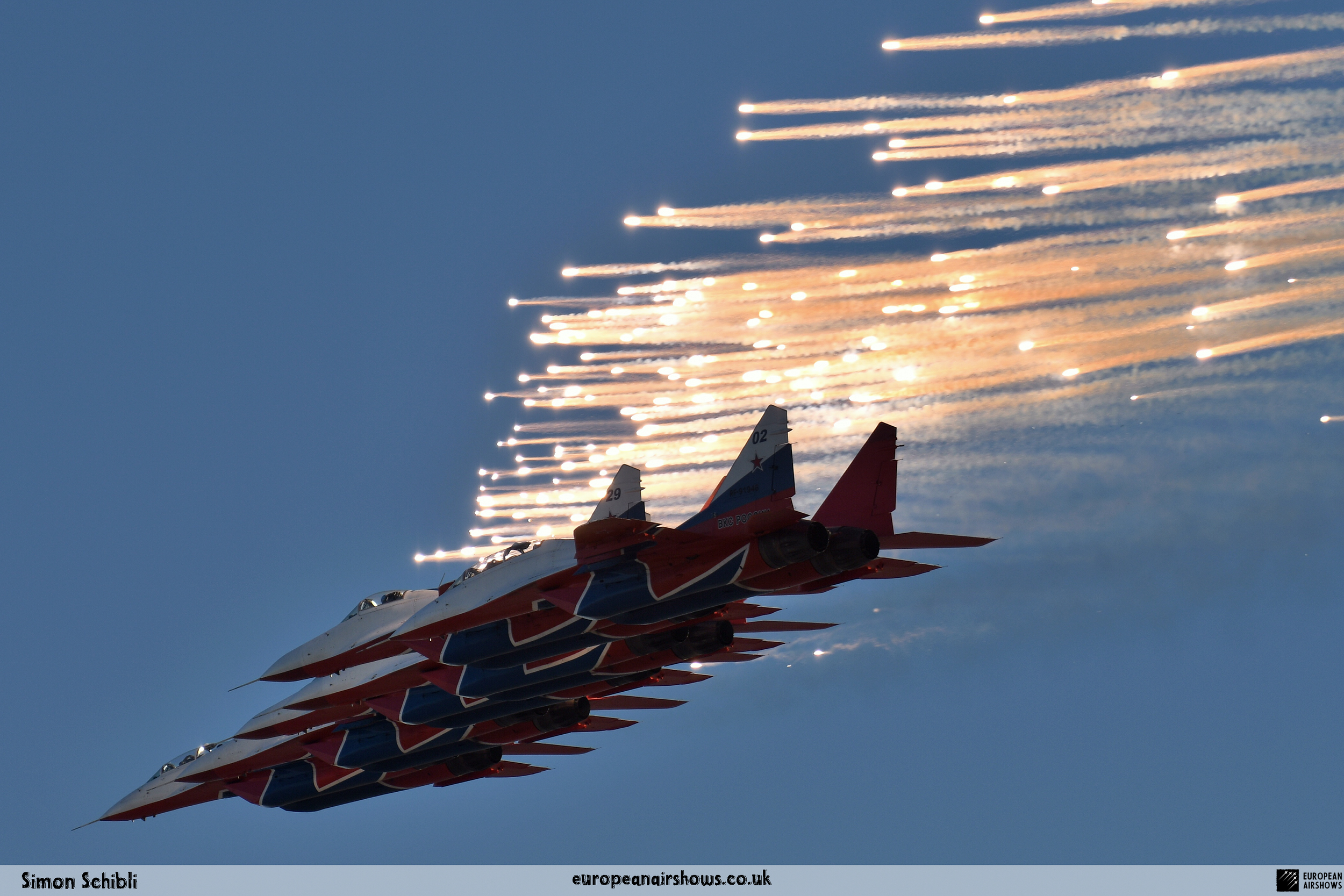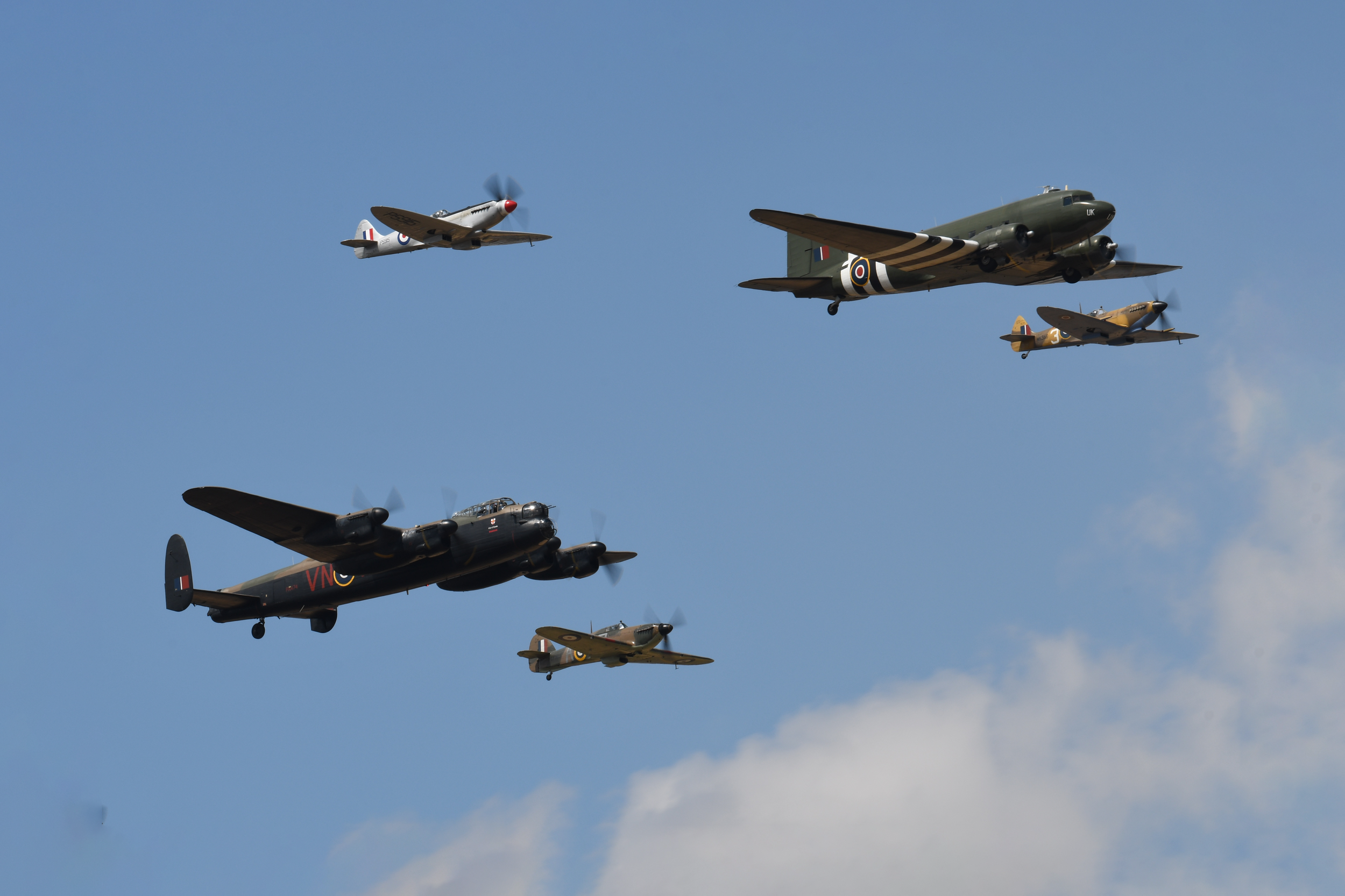Swifts Aerobatic Team
Country
Russia
Size
6 to 9 Aircraft
Base
Kubinka Air Base
The Swifts is an aerobatic demonstrator team of the Russian Air Force. It was formed on May 6th, 1991, on the basis of the 234th Guards Proskurov Aviation Regiment from the best pilots of the Kubinka airbase near Moscow. It is part of the I. N. Kozhedub Aviation Equipment Show Center and performs formation and solo aerobatics on multipurpose highly manoeuvrable MiG-29 fighters jets.
"Swifts" are based at the Kubinka Air Base located 60 kilometres from Moscow. The pilots of Kubinka were the first in the USSR to master solo and formation aerobatics on fighter jets. Today Kubinka is known as the number 1 school of aerobatic skills in Russia. In early May 2011, the Swifts aerobatic team celebrated its 20th anniversary with a new display routine. Five years later, on May 21st, 2016, the Strizhi aerobatic team celebrated its quarter-century anniversary, which they celebrated together with the Russian Knights.
The "Swifts" aerobatic group is part of the 234th Guards Proskurovsky Fighter Aviation Regiment of the 16th Air Army. Its history dates back to the 1950s when the formation of the new 234th Fighter Aviation Regiment began and the aerobatic pilots became the backbone of the flight crew. The main task of the regiment was to prepare and conduct traditional air parades over Moscow, the first of which took place on May 1st, 1951.
History
Since the mid-1950s, ground and flight demonstrations of military aviation equipment have been held in Kubinka for students of military academies, the leadership of the Ministry of Defense and the General Staff, the leaders of the Soviet state and the Communist Party, delegates to the CPSU congresses, as well as state and military delegations of foreign states. Since the early 1960s, the pilots of the 234th "aerobatic" regiment, in addition to combat training, participation in air parades and demonstrations of aviation equipment, began to regularly escort the aircraft of heads and leaders of foreign states arriving in Moscow in the air. In addition to the aircraft of official delegations, the pilots of the regiment also escorted aircraft carrying the first Soviet cosmonauts.
On July 9th, 1961, on the Day of the USSR Air Force, a grand air parade was held in Tushino, in which the pilots of the 234th regiment took an active part
In 1983, the 234th Guards Fighter Aviation Regiment was the first in the Soviet Air Force to begin flying the MiG-29 fighter jets. In 1986, a group of six MiG-29s visited the Finnish Rissal airbase, during which Soviet fourth-generation fighters were shown abroad for the first time. In 1990, the squadron pilots flying the MiG-29 were tasked with mastering aerobatics in close formation, consisting of six aircraft. The pilots flew with an interval and distance of about 3 meters, performing a complex set of figures.
In 1988, two MiG-29 visited the air show in Farnborough (UK), a year later they showed in Le Bourget (France). Preparing for the international debut, the pilots thought about the image side of their activities. For the MiG-29 and MiG-29UB planes, they came up with an original colouring - white fuselages and bright blue keels, blue lightning passed along the sides, the group's emblems appeared on the air intakes under the influx - black swifts on a red background. These nimble birds gave the name to the group - the group went down in history under the name "Swifts".
On May 6th 1991 the Swifts performed their debut display under the current name and showed off their original colours, this event was closed to the public. Later this month the team travelled to Sweden and displayed at the Uppsala Airshow an event also closed to the public with only a few media representatives allowed access. The first public display of the Swifts took place in May 1992, when the group was invited to take part in a grand air festival at Reims Air Base, held in honour of the 50th anniversary of the famous Normandie-Niemen regiment. For two years, the team performed more than 50 displays at airshows and official events in Kubinka and various cities of Russia.
In 1993, the group took part in the MAKS-93 air show, and in the fall of the same year visited Belgium and Thailand. In December, the Swifts were invited to participate in the LIMA-93 air show. The planes were delivered to Malaysia disassembled by military transport aircraft. Then the aerobatic team "Swifts" was awarded the title of "The best aerobatic team in the world."
In 1994, the Swifts took part in an air show at the Sprenger airfield in Germany. In May 1995, the squadron served as an escort for the Tu-160 leader's plane over Poklonnaya Gora during a grand air parade in honour of the 50th anniversary of Victory in the Great Patriotic War. In August of the same year, they took part in the MAKS-95 air show.
In 1996, they took part in the Gelendzhik-95 seaplane show and also travelled abroad, taking part in an air show at the Finnish base of Oulu. 1997 was marked by a rich program of performances at an air show in the Bulgarian city of Varna, a visit to Holland as part of a Russian military delegation, a performance at MAKS-97, as well as performance over Tushino at an air festival in honour of the 850th anniversary of Moscow. At the 1997 international air show in Finland, the group commander Nikolai Dyatel won first place in solo aerobatics.
In 1999 most of the team pilots retired and the team was disbanded. On the 23rd of November 2000, the team was reborn with new pilots and flew only four aircraft.
The year 2001, which opened the new millennium, became in some ways a milestone for "Swifts". The ranks of the group were replenished with new pilots. Guards Lieutenant Colonel Vadim Shmigelsky began to work out the solo aerobatics program, and in October 2001, at a festival in Astrakhan, he performed his first show. Guards Lieutenant Colonel Mikhail Loginov, Guard Majors Valery Morozov, Igor Sokolov, Sergey Osyaykin, Dmitry Koposov, Guard Captain Alexei Prokhorov began to master formation aerobatics. Winter and spring were spent on intense training, and in September 2002 the group brilliantly performed over the sea bay in Gelendzhik during the next seaplane show.
In the winter of 2003, the MiG-29 aircraft underwent scheduled repairs and acquired a new paint scheme. MiGs were repainted in a new red and white uniform with a bright blue silhouette of a swift above and below, the letters "MiG" on the keels. For the first time in a new guise, they were shown to the public on March 15th, 2003 during the celebration of the 65th anniversary of the regiment. From this moment, active cooperation with the aerobatic team " Russian Knights " began. This year, at the Kubinka airbase, a huge work was carried out to replace the coating and equipment of the runway, during which the aerobatic teams flew to the airbase in Andreapol. On the 27th of July 2003, one of the team's two-seat MiG-29UB crashed after takeoff from Perm's airport in Russia where the Strizhi landed to refuel. It was reported that the bad runaway conditions caused the pilot to lose control and crash into the grass beside the runway. Both pilots managed to eject successfully.
In subsequent years, the group actively participated in air shows in Russia and abroad. In 2007, seven MiG-29 aircraft took off from the runway of the Kubinka airbase, headed to the United Arab Emirates where the team was invited to participate at the Al Ain Airshow. "Swifts" have also taken part in every MAKS air show and on May 9th, 2010, the group flew over Red Square together with the "Russian Knights" during the air part of the Victory Parade.
In early June 2011, information appeared that the aerobatic team will be disbanded something that later proved to be wrong.
At the beginning of May 2012, the team, together with Russian Knights, was supposed to take part in the KADEX-2012 exhibition in Astana. The visit, however, was disrupted for unknown reasons, despite the existing international agreements and lengthy preparations. On the scheduled days, the pilots flew through Engels to Chelyabinsk, but they never received permission to cross the border and fly to Kazakhstan from the Russian government. On May 5th, the team returned to Kubinka where it remains to this day.
| Back to Top |
Mikoyan MiG-29A Fulcrum A
The Mikoyan MiG-29A is the Initial production version of the twin-engine jet fighter aircraft designed in the Soviet Union. Developed by the Mikoyan design bureau as an air superiority fighter during the 1970s, the MiG-29, along with the larger Sukhoi Su-27, was developed to counter new U.S. fighters such as the McDonnell Douglas F-15 Eagle and the General Dynamics F-16 Fighting Falcon. The MiG-29 entered service with the Soviet Air Forces in 1982.
While originally oriented towards combat against any enemy aircraft, many MiG-29s have been furnished as multirole fighters capable of performing a number of different operations, and are commonly outfitted to use a range of air-to-surface armaments and precision munitions. The MiG-29 has been manufactured in several major variants, including the multirole Mikoyan MiG-29M and the navalised Mikoyan MiG-29K; the most advanced member of the family to date is the Mikoyan MiG-35. Later models frequently feature improved engines, glass cockpits with HOTAS-compatible flight controls, modern radar and infrared search and track (IRST) sensors, and considerably increased fuel capacity; some aircraft have also been equipped for aerial refuelling.
Following the dissolution of the Soviet Union, the militaries of a number of former Soviet republics have continued to operate the MiG-29, the largest of which is the Russian Air Force. The Russian Air Force wanted to upgrade its existing fleet to the modernised MiG-29SMT configuration, but financial difficulties have limited deliveries. The MiG-29 has also been a popular export aircraft; more than 30 nations either operate or have operated the aircraft to date.
Sharing its origins in the original PFI requirements issued by TsAGI, the MiG-29 has broad aerodynamic similarities to the Sukhoi Su-27, however, there are some notable differences. The MiG-29 has a mid-mounted swept wing with blended leading-edge root extensions (LERXs) swept at around 40°; there are swept tailplanes and two vertical fins, mounted on the booms outboard of the engines. Automatic slats are mounted on the leading edges of the wings; they are four-segment on early models and five-segment on some later variants. On the trailing edge, there are manoeuvring flaps and wingtip ailerons.
The MiG-29 has hydraulic controls and an SAU-451 three-axis autopilot but, unlike the Su-27, no fly-by-wire control system. Nonetheless, it is very agile, with excellent instantaneous and sustained turn performance, high-alpha capability, and general resistance to spins. The airframe consists primarily of aluminium with some composite materials and is stressed for up to 9g manoeuvres. The controls have "soft" limiters to prevent the pilot from exceeding g and alpha limits, but the limiters can be disabled manually.
The MiG-29 has two widely spaced Klimov RD-33 turbofan engines, each rated at 50.0 kilonewtons dry and 81.3 kilonewtons in afterburner. The space between the engines generates lift, thereby reducing effective wing loading, hence improving manoeuvrability. The engines are fed through intake ramps fitted under the leading-edge extensions, which have variable ramps to allow high-Mach speeds. As an adaptation to rough-field operations, the main air inlet can be closed completely and the auxiliary air inlet on the upper fuselage can be used for takeoff, landing and low-altitude flying, preventing ingestion of ground debris. Thereby the engines receive air through louvres on the LERXs which open automatically when intakes are closed. However, the latest variant of the family, the MiG-35, eliminated these dorsal louvres and adopted the mesh screens design in the main intakes, similar to those fitted to the Su-27.
The MiG-29 has a ferry range of 1,500 km without external fuel tanks and 2,100 km with external tanks. The internal fuel capacity of the original MiG-29B is 4,365l distributed between six internal fuel tanks, four in the fuselage and one in each wing. For longer flights, this can be supplemented by a 1,500l centreline drop tank and, on later production batches, two 1,150l underwing drop tanks. In addition, newer models have been fitted with port-side inflight refuelling probes, allowing much longer flight times by using a probe-and-drogue system.
The cockpit features a conventional centre stick and left-hand throttle controls. The pilot sits in a Zvezda K-36DM ejection seat which has had an impressive performance in emergency escapes. The cockpit has conventional dials, with a head-up display (HUD) and a Shchel-3UM helmet-mounted display, but no HOTAS ("hands-on-throttle-and-stick") capability. The emphasis seems to have been placed on making the cockpit similar to the earlier MiG-23 and other Soviet aircraft for ease of conversion, rather than on ergonomics. Nonetheless, the MiG-29 does have substantially better visibility than most previous Russian jet fighters, thanks to a high-mounted bubble canopy. Upgraded models introduce "glass cockpits" with modern liquid-crystal (LCD) multi-function displays (MFDs) and true HOTAS.
The baseline MiG-29B has a Phazotron RLPK-29 radar fire control system which includes the N019 Sapfir 29 look-down/shoot-down coherent pulse-Doppler radar and the Ts100.02-02 digital computer. The N019 radar was not a new design, but rather a development of the Sapfir-23ML architecture used on the MiG-23ML. During the initial design specification period in the mid-1970s, Phazotron NIIR was tasked with producing a modern radar for the MiG-29. To speed development, Phazotron based its new design on work undertaken by NPO Istok on the experimental "Soyuz" radar program. Accordingly, the N019 was originally intended to have a flat planar array antenna and fully digital signal processing, for a detection and tracking range of at least 100 km against a fighter-sized target. Prototype testing revealed this could not be attained in the required timeframe and still fit within the MiG-29's nose. Rather than design a new radar, Phazotron reverted to a version of the Sapfir-23ML's twisted-polarization Cassegrain antenna and traditional analogue signal processors, coupled with a new NII Argon-designed Ts100 digital computer to save time and cost. This produced a working radar system, but inherited the weak points of the earlier design, plaguing the MiG-29's ability to detect and track airborne targets at ranges available with the R-27 and R-77 missiles. The N019 was further compromised by Phazotron designer Adolf Tolkachev’s betrayal of the radar to the CIA, for which he was executed in 1986. In response to all of these problems, the Soviets hastily developed a modified N019M Topaz radar for the upgraded MiG-29S aircraft. However, VVS was reportedly still not satisfied with the performance of the system and demanded another upgrade. The latest upgraded aircraft offered the N010 Zhuk-M, which has a planar array antenna rather than a dish, improving range, and much superior processing ability, with multiple-target engagement capability and compatibility with the Vympel R-77 (or RVV-AE).
Armament for the MiG-29 includes a single GSh-30-1 30 mm cannon in the port wing root. This originally had a 150-round magazine, which was reduced to 100 rounds in later variants. Original production MiG-29B aircraft cannot fire the cannon when carrying a centerline fuel tank as it blocks the shell ejection port. This was corrected in the MiG-29S and later versions.
Three pylons are provided under each wing (four in some variants), for a total of six (or eight). The inboard pylons can carry either a 1,150l fuel tank, one Vympel R-27 (AA-10 "Alamo") medium-range air-to-air missile, or unguided bombs or rockets. Some Soviet aircraft could carry a single nuclear bomb on the port inboard station. The outer pylons usually carry R-73 (AA-11 "Archer") dogfight air to air missiles, although some users still retain the older R-60 (AA-8 "Aphid"). A single 1,500l tank can be fitted to the centerline, between the engines.
| Back to Top |
Mikoyan MiG-29UB Fulcrum B
The Mikoyan MiG-29UB is a twin-seat training model of the Mig-29A. It has an Infra-red sensor mounted only and no radar. Developed by the Mikoyan design bureau as a two-seat supersonic jet trainer based on the single-seat Mig-29A and was designed for more effective pilot fighter pilot training. An elevated Instructors cockpit was installed behind the trainee’s cockpit and was equipped with control elements, an indication system and also with ejection seat K-36DM. Flight qualities of the two-seat Fulcrum are the same as the qualities of the one-seated aircraft: with an average takeoff weight of 14600kg, the maximum speed of 2400km/h, maximum G limits of +9G and 330m/s rate of climb. On the high-altitudes, several qualities of the Mig-29UB are slightly reduced: with the maximum speed being 2230km/h instead of 2400km/h, optimum cruise altitude being 57400ft instead of 59000ft and the range of 680km instead of 710km close to the ground and 1410km instead of 1430km on the high flight levels. The first flight of the MiG-29UB took place on the 29th of April 1985.
| Back to Top |
